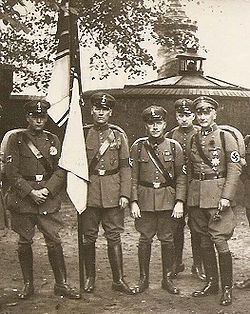Slug
de:Stahlhelm, Bund der Frontsoldaten en:Stahlhelm, Bund der Frontsoldaten

The Stahlhelm, Bund der Frontsoldaten (Template:Lang-en, League of Frontline Soldiers) was one of the many paramilitary organizations that arose after the defeat of World War I in the Weimar Republic. It operated, in general, as the armed branch of the Deutschnationalen Volkspartei (DNVP) so it was placed generally at DNVP gatherings in the position of (armed) Protector of the Hall (Saalschutz).
1918 to 1933
The Stahlhelm was founded at the end of 1918 partly by Franz Seldte in the city of Magdeburg. Its journal, Stahlhelm, was edited by Count Hans-Jürgen von Blumenthal, later hanged for his part in the July 20 plot. The organization was a rallying point for nationalistic and anti-Weimar elements. Within the organization a worldview oriented toward the prior imperial regime predominated. Jewish veterans were denied admission and formed a separate Reichsbund jüdischer Frontsoldaten. From 1924 on, in several subsidiary organizations, new recruits and veterans with front line experience would provide a standing armed force in support of the Reichswehr beyond the 100,000 allowed by the Treaty of Versailles. With 500,000 members in 1930, the Stahlhelm was the largest paramilitary organization of Weimar Germany.
Financing was provided by the Deutsche Herrenklub, the Eastern landed gentry, and like-minded entrepreneurs.
Although the Stalhelm was officially non-party entity, above party politics, after 1929 it took on a anti-republican and anti-democratic character. Its goals were a German Dictatorship, the preparation of a Revanchist program, and the direction of local anti-parlementarian action. For this reason its members distinguished themselves from the NSDAP as "German Fascists". Among their futher demands were the establishment of a Greater Germanic Peoples Reich, struggle against Social Democracy, the "merchantilism of the Jews" and the general liberal democratic worldview, and attempted without success to place candidates favorable to the politics of a German expansion to the East.
In 1929 the Stahlhelm joined the Peoples Initiative Against the Young-Plan to demonstrate against the Young Plan. The Stahlhelm joined the DNVP, NSDAP under Adolf Hitler and Alldeutscher Verband to form the Harzburger Front, which was a united right-wing front against the Weimar Republic and the Harzburger Front. In the presidential elections of 1932 Theodor Duesterberg was the Stalhelm candidate.
1933 to 1945
Disarmament Incident in Braunschweig
A raid with the intention of disarmament by the SA on Stahlhelm in Brauschweig that took place on 27 March 1933 is characteristic of the pressure applied by the NSDAP on Stalhelm in this period, the so-called Stahlhelm Putsch.
Seldtes Joins the SA
Seldte became Reichsminister for Labor in Hitlers cabinet. In April 1933, he joined the SA.
Gleichschaltung 1934
After their assumption of power, there were massive attempts by the Nazis to integrate Stahhelm into the NSDAP, finally succeeding in 1934 in the "voluntary Gleichschaltung". In 1934 the Stahlhelm was renamed Nationalsozialistischer Deutscher Frontkämpferbund (Federation of the National Socialist Frontline-Fighters) and integrated into the Sturmabteilung and, in 1935, it was dissolved by the Nazis, who feared its fundamentally monarchist character.
After 1945
In 1951 the Stahlhelm Bund der Frontsoldaten was re-created in Cologne. A year later, in 1952, even before his release from prison, Field Marshal Albert Kesselring was elected as leader federal of the neonazi association,[1] a post he kept till his death in 1960.
See also
- Emanuel Schäfer (member from 1925 to 1928)
- Kyffhäuserbund
- Queen Louise League
- SA
- SS
- Stahlhelm
- Weimar paramilitary groups
Notes
- ↑ Bund der Frontsoldaten' wahlt Kesselring zum Prasidenten, National Zeitung, 8 August 1952.
External links
fr:Stahlhelm, Bund der Frontsoldaten it:Stahlhelm, Bund der Frontsoldaten nl:Stahlhelm, Bund der Frontsoldaten ja:鉄兜団、前線兵士同盟 no:Stahlhelm, Bund der Frontsoldaten pl:Stahlhelm (organizacja paramilitarna) ru:Стальной шлем fi:Stahlhelm